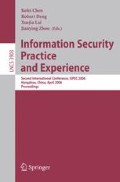Abstract
In this paper, we propose a new approach to detect network attacks. Network connections are first transformed into data points in the feature space we predetermined. With the field concept in physics, we consider each point like an electric charge exerts a force on others around it and therefore forms a field which we call data field. Each incoming data object would obtain an amount of the potential energy from the field, from which we can recognize the class of such object. We evaluated our approach over KDD Cup 1999 data set. Experimental results show most attacks can be correctly discriminated in our data field and the false positive rate is acceptable. Compared with other approaches, our method has the better performance in detection of PROBE and U2R attacks.
Access this chapter
Tax calculation will be finalised at checkout
Purchases are for personal use only
Preview
Unable to display preview. Download preview PDF.
References
Amor, N.B., Benferhat, S., Elouedi, Z.: Naive Bayes vs. Decision Trees in Intrusion Detection Systems. In: Proc. of the 19th ACM Symposium on Applied Computing, SAC 2004 (2004)
Barbara, D., Couto, J., Jajodia, S., Wu, N.: ADAM: A Testbed for Exploring the Use of Data Mining in Intrusion Detection. SIGMOD Record (2001)
Barbara, D., Couto, J., Jajodia, S., Wu, N.: ADAM: Detecting Intrusions by Data Mining. In: Proc. of the IEEE Workshop on Information Assurance and Security, West Point, NY (June 2001)
Denning, D.: An Intrusion Detection Model. IEEE Transactions on Software Engineering SE-13, 222–232 (1987)
Ertoz, L., Eilertson, E., Lazarevic, A.: Detection of Novel Network Attacks Using Data Mining. In: Proc. of Workshop on Data Mining for Computer Security (November 2003)
Ertoz, L., Eilertson, E., Lazarevic, A.: The MINDS - Minnesota Intrusion Detection System. In: Proc. of Workshop on Next Generation Data Mining (2004)
Eskin, E., Arnold, A., Prerau, M., Portnoy, L., Stolfo, S.J.: A Geometric Framework for Unsupervised Anomaly Detection: Detecting Intrusions in Unlabeled Data. In: Proc. of Application of Data Mining in Computer Security. Kluwer, Dordrecht (2002)
Fan, W., Stolfo, S.J., Zhang, J., Chan, P.K.: AdaCost: Misclassification Costsensitive Boosting. In: Proc. of the 16th International Conference on Machine Learning (1999)
KDD Cup 1999 Data, http://kdd.ics.uci.edu/databases/kddcup99/kddcup99.html
Lee, W., Stolfo, S.J., Mok, K.W.: Mining Audit Data to Build Intrusion Detection Models. In: Proc. of the 4th International Conference on Knowledge Discovery and Data Mining, New York (August 1998)
Lee, W., Stolfo, S.J., Mok, K.W.: A Data Mining Framework for Building Intrusion Detection Models. In: Proc. of the IEEE Symposium on Security and Privacy (May 1999)
Levin, I.: KDD-99 Classifier Learning Contest LLSoft’s Results Overview. SIGKDD Explorations 1(2), 67–75 (2000)
Oldmeadow, J., Ravinutala, S., Leckie, C.: Adaptive Clustering for Network Intrusion Detection. In: Dai, H., Srikant, R., Zhang, C. (eds.) PAKDD 2004. LNCS (LNAI), vol. 3056, pp. 255–259. Springer, Heidelberg (2004)
Pfahringer, B.: Winning the KDD99 Classification Cup: Bagged Boosting. SIGKDD explorations 1(2), 65–66 (2000)
Portnoy, L., Eskin, E., Stolfo, S.: Intrusion Detection with Unlabeled Data Using Clustering. In: Proc. of ACM CSS Workshop on Data Mining Applied to Security (2001)
Ye, N., Chen, Q.: An Anomaly Detection Technique Based on a Chi-Square Statistic for Detecting Intrusions into Information Systems. Quality and Reliability Engineering International 17(2), 105–112 (2001)
Author information
Authors and Affiliations
Editor information
Editors and Affiliations
Rights and permissions
Copyright information
© 2006 Springer-Verlag Berlin Heidelberg
About this paper
Cite this paper
Xie, F., Bai, S. (2006). Using Data Field to Analyze Network Intrusions. In: Chen, K., Deng, R., Lai, X., Zhou, J. (eds) Information Security Practice and Experience. ISPEC 2006. Lecture Notes in Computer Science, vol 3903. Springer, Berlin, Heidelberg. https://doi.org/10.1007/11689522_8
Download citation
DOI: https://doi.org/10.1007/11689522_8
Publisher Name: Springer, Berlin, Heidelberg
Print ISBN: 978-3-540-33052-3
Online ISBN: 978-3-540-33058-5
eBook Packages: Computer ScienceComputer Science (R0)

